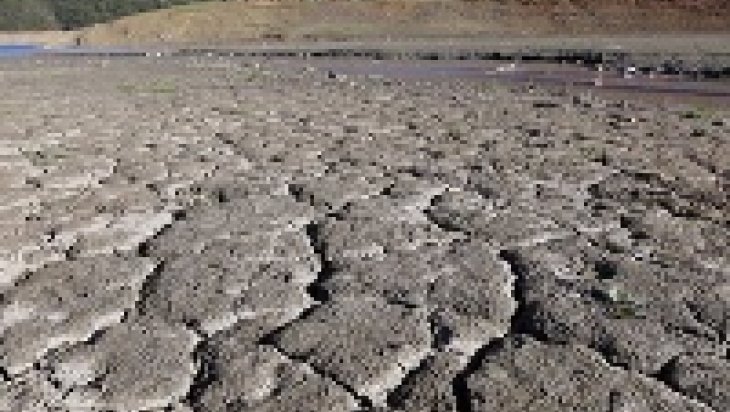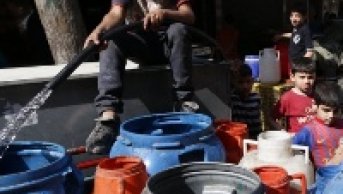Drought in Turkey and The Torrid Effects*

The rising population and urbanization, climate change, and industrial and agricultural activities increase the pressure on available water resources. Especially in regions, including Turkey, where arid and semi – arid climate prevails, the pressure is considerably high.
While the average annual precipitation of our planet is 1050 millimeters, the figures provided by Turkey's General Directorate of the State Hydraulic Works (DSI) show that the average annual precipitation in Turkey is 643 mm. Furthermore, the total amount of rainfall is not evenly distributed across the country.
Prof. Dr. Malin Falkenmark, one of the world's most prominent hydrologists, conducted a study in 1989 by taking into consideration the needs of the natural system. She prepared an index, pointing out the pressure of population growth on water resources, based on the proportion between total population and total water resources in various countries.
In the indicator named after Falkenmark (water stress index), the threshold value is defined as 1,700 m3 of water per capita on annual basis. According to the index, a country or region is said to experience water stress when annual water supplies drop below 1,700 cubic meters per capita per year. When water supplies drop below 1,000 cubic meters per capita per year, the country faces water scarcity. And dropping below 500 cubic meters per capita per year means chronic water scarcity.
The Falkenmark water stress index indicates that annual per capita water availability in Turkey is 1,600 cubic meters in 2013. Accordingly, it might be suggested that Turkey currently faces water stress. By the year 2023, this amount will decline to 1,125 m3 per capita/year and Turkey will face water scarcity with an expected population of 100 million in the country.
Water Stress in Turkey
According to DSI statistics, water use, related to sectors in Turkey in 2013, is listed as follows: 71 percent is used in irrigation sector, 14 percent as domestic water, and 14 percent in industry. It is expected that the amount of water used for irrigation and domestic purposes will double, while it will triple in industrial production by 2023.
In Turkey, as well as all across the world, population growth and thus rising food and energy needs cause pressure on water resources. The impact of global climate change on water resources is an undeniable fact.
The official figures show that in 2014, Turkey has endured the driest year since 1961. The impacts of drought lead to challenges in meeting the water need particularly in metropolitan cities, and directly affect agricultural sector where water is most needed. Especially the decline in the amount of dry agricultural products causes increases in food prices, including grains.
Uncontrolled use of groundwater resources in the regions with insufficient amount of surface water (rivers and lakes) stands out as a problem in Turkey. Utilization of illegal agricultural wells is a major problem. Despite the legal regulations on illegal wells, the problem related to using illegal wells cannot somehow be solved.
In addition to illegal agricultural wells; uncontrolled use and overexploitation of groundwater resources lead to drying of wells, increased sinkholes, and shrinking or even depletion of groundwater recharge areas (e.g. lake, river). Drying of Lake Seyfe (Kırşehir, Mucur) and Lake Meke (Konya, Karapınar) in recent years sets an example to this situation.
Based on the interdependence between water and energy, Turkey gets some 22 percent of its electricity from hydropower. The most important thing about Hydroelectric Power Plants (HPP), and one of the reasons why they are preferred, is that they can be ramped up and down very quickly to adapt to changing energy demands since it takes 3 to 5 minutes to bring a unit from cold start-up to full load and to decrease power generation quickly when there is a surplus power generation. The aforesaid advantage is what makes the major difference from other power plants (thermal, nuclear etc.).
The decline in water levels of dam reservoirs stemming from drought causes problems in hydroelectric power generation. The ongoing drought leads to delays for the dam reservoirs to reach their former capacities for the next years which might even prevent some HPPs from generating power.
Drought stands out as a major problem in the Middle East, as well as in Turkey, through water, food, and energy problems. The drought in 2010 which prevailed all across the world and hit production capacities of especially grain exporting countries increased food and particularly bread prices in the grain importing countries in the Middle East and North Africa. Drought and its impacts are mentioned among the causes of uprisings in the Middle East which broke out in early 2011.
Solution Offers
It is worrying that the current drought in Turkey might lead to hydrological drought and continues to affect water resources in the upcoming year. Water resources are the first to suffer from the climate change. According to the studies carried out so far, it is expected that the temperature will rise by 2,5 – 3,5 Celsius degrees and precipitation will decrease at a rate of 25-35 percent all around Turkey in the forthcoming years. This change will also have a negative impact on Turkey's water budget and increase the water stress in Turkey.
It is essential to take immediate measures to prevent potential water shortage and make plans. Thus, demand-oriented management (by efficiently using water resources through limiting demand on water, and setting institutional and administrative structure to save water) should be focused on rather than supply-oriented management. It is essential for sustainable water resources management to be flexible and effective enough to fight against and adjust into new climate conditions, dry spells, and new precipitation patterns.
In Turkey, some 50 percent of water in municipal water system is lost while conveying water from resource to households. Old and worn out water mains must be repaired or replaced with new ones in order to minimize the water loss.
Adding drought to increasing water need in metropolitan cities, there is a major problem in meeting the water demand. When the dams constructed to provide drinking water remain insufficient, water is conveyed from various basins to metropolitan cities such as Istanbul and Ankara. During the inter-basin water transfer, calculating the water need of donor basin must be one of the most important criterions. Also, it is a must for sustainability of inter-basin water transfer project to be integrated with environmental, agricultural, social, and economic policies.
Groundwater is mainly used in agricultural field. In irrigation methods, modern water-saving irrigation techniques should be encouraged. The aforesaid techniques (sprinkling, drip irrigation etc.) keep the water loss between 5-20 percent. The loss reached much higher levels in conventional irrigation methods. In the recent years, farmers have been provided with various promotions and means to encourage them to apply modern irrigation techniques. This is a major step to save water; however, the implementation of such techniques must be controlled and monitored.
Methods such as storing rainwater in rooftops and using the water in irrigation through “rainwater harvesting” method are of great importance. There is no doubt that the most important factor preventing water losses are water users. Understanding the fact that Turkey is not a water-rich country and each person/household plays a major role in saving water is the key solution to raise awareness among consumers. The knowledge could be spread through awareness projects to be carried out by private or government organizations, the media, and schools.
*This article was published in Al Jazeera Turk (AJT) on August 2nd, 2014.







